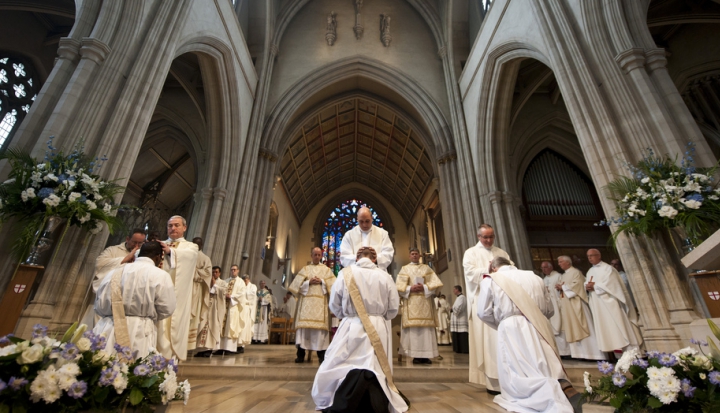Our understanding of priests, bishops, and deacons has changed dramatically in the church’s long history, says historian Gary Macy.
In this web-only excerpt from our interview Get the facts in order: A history of women’s leadership in the church, historian and theologian Gary Macy says that bishops, priests, and deacons in the early church functioned very differently than they do today. Among the differences, bishops of the past were essentially married to their dicoeses and could not leave for another more desireable location.
In what ways has our theology of bishops, priests, and deacons changed throughout history?
For one thing, the Council of Nicaea talked about bishops who moved to another diocese as adulterers. You were never, ever, ever supposed to do that. It’s not until the 11th century that the Western church started to get popes who were bishops somewhere other than Rome. Of course sometime a bishop did move from one see to another for political reasons, but it was certainly frowned upon.
The rule in canon law, until the 1917 Code of Canon Law changed it, was that a bishop, for instance, was supposed to be chosen by his community, more particularly by the priests of the diocese with the approval of the people. Of course politics changed that in some cases, but the law doesn’t change really until the turn from the 19th to 20th century when the Pope began to assert the right to appoint more and more bishops until the practice of the Pope appointing bishops was enshrined in Canon Law in 1917.
We do not have a long history of appointing bishops from outside their own communities in Christianity. The older practice is that bishops are picked by their community and appointed to that community. Deacons and priests were picked by the Bishop, however, since priests and deacons married, their posts were often hereditary. You’re not supposed to leave your own community and you don’t have power outside that community. So you’re not given a power by ordination; you’re given a job to do within that community. If you’re a priest in one diocese, that doesn’t mean you’re a priest in another diocese. That changes all in the 12th and 13th century.
When the understanding of ordination shifts focus to the power to consecration the bread and wine?
Right. Edward Schillebeek, the famous Dutch theologian, has a great line about church leadership in the past: “Under that system, you led the liturgy because you were the leader of the people. You didn’t lead the liturgy because you were ordained to have the power of consecration. You have the power of consecration because you were the leader of that congregation.” This is a reverse of the later understanding of ordination.
So, the ancient church would have found it really reprehensible to bring a bishop in from somewhere else to lead your congregation. The second time a bishop from outside of Rome (he was Formosus, Bishop of Porto) was named pope was eventually deposed. He was dead already, so it didn’t matter to him. Pope Stephen VI dressed him up in his robes, cut off his fingers, took off the robes, and threw him in the Tiber. And one the reasons they did that are because he had been bishop somewhere else and you just couldn’t do that. It was considered adultery.
So, the practices we have would have been very foreign to those people. Extremely strange to them. And vice versa. It’s hard for us to think back to the way that ordination would have operated.
Looking at this change from a liturgical standpoint, you have to ask, “Who has the power to do things?” Considering ordination as what gives a priest the power to consecrate seems to makes those of us who aren’t ordained into passive consumers of whatever the person with the power has.
Scholars have also pointed out another source for that increased importance of power and authority: Roman law. Who has the authority to do what is very important in Roman law and after the big recovery of Roman law in the 11th and 12th centuries, they began to use a lot of Roman law in theology.
I can’t tell you which was the more important. Some people say Roman law. Some people say Aristotle. I don’t think they’re wrong. But it just happened that all of this was at the same time.
When you ask why is it that women were written out of the picture, it seems several streams, like the revival of Roman law and Aristotelian philosophy, come together. Not one of them alone would explain it.
This article is a web-only feature that accompanies Get the facts in order: A history of women’s leadership in the church which appeared in the January 2013 issue of U.S. Catholic (Vol. 78, No. 1, pages 18-22).
Image: Photo by Catholic Church (England and Wales) cc via Flickr













Add comment